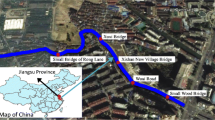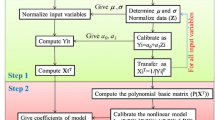Abstract
A research was made on the potential use of neural network based models in eutrophication modelling. As a result, an algorithm was developed to handle the practical aspects of designing, implementing and assessing the results of a neural network based model as a lake management tool. To illustrate the advantages and limitations of the neural network model, a case study was carried out to estimate the chlorophyll-aconcentration in Keban Dam Reservoir as a function of sampled water quality parameters (PO4phosphorus, NO3nitrogen, alkalinity, suspended solids concentration, pH, water temperature, electrical conductivity, dissolved oxygen concentration and Secchi depth) by a neural network based model. Alternatively, the same system was solved with a linear multiple regression model in order to compare the performances of the proposed neural network based model and the traditional linear multiple regression model. For both of the models, the linear correlation coefficients between the logarithms of observed and calculated chlorophyll-aconcentrations were calculated. The correlation coefficient R, the best linear fit between the observed and calculated values, was evaluated to assess the performances of the two models. R values of 0.74 and 0.71 were obtained for the neural network based model and the linear multiple regression model, respectively. The study showed that the neural network based model can be used to estimate chlorophyll-awith a performance similar to that of the traditional linear multiple regression method. However, for cases where the input and the output variables are not linearly correlated, neural network based models are expected to show a better performance.
Similar content being viewed by others
References
Demuth, H. & M. Beale, 1998. Neural Network Toolbox User's Guide. The MathWorks Inc., Natick, MA.
Hagan, M. T. & M. Menhaj, 1994. Training feedforward networks with the Marquardt algorithm, IEEE Transactions on Neural Networks, 5: 989–993
Karul, C., S. Soyupak & E. Germen, 1998. A new approach to mathematical water quality modelling in reservoirs: Neural networks. Int. Rev. Hydrobiol. 83: 689–696
Keiner, L. E. & C. W. Brown, 1998. A Neural Network as a non-linear chlorophyll estimation algorithm. http://orbit19i.nesdis.noaa.gov/_lkeiner/seanam_neur al/seabam2.htm
Recknagel, F., M. French, P. Harkonen & K. Yabunaka, 1997. Artificial neural network approach for modelling and prediction of algal blooms. Ecol. Model. 96: 11–28.
Ryding, S. & W. Rast, 1989. The control of eutrophication of lakes and reservoirs. Parthenon Publishing. Co., UNESCO.
Scardi, M., 1996. Artificial neural networks as empirical models for estimating phytoplankton production. Mar. Ecol. Prog. Ser. 139: 289–299.
Simpson, P. K., 1990. Artificial Neural Systems: Foundations, Paradigms, Applications and Implementations. Pergamon Press Inc., New York.
Yabunaka, K., M. Hosomi & A. Murakami, 1997. Novel application of a back-propagation artificial neural network model formulated to predict algal bloom. Wat. Sci. Tech. 36: 89–97
Author information
Authors and Affiliations
Rights and permissions
About this article
Cite this article
Karul, C., Soyupak, S. & Yurteri, C. Neural network models as a management tool in lakes. Hydrobiologia 408, 139–144 (1999). https://doi.org/10.1023/A:1017007313690
Issue Date:
DOI: https://doi.org/10.1023/A:1017007313690




